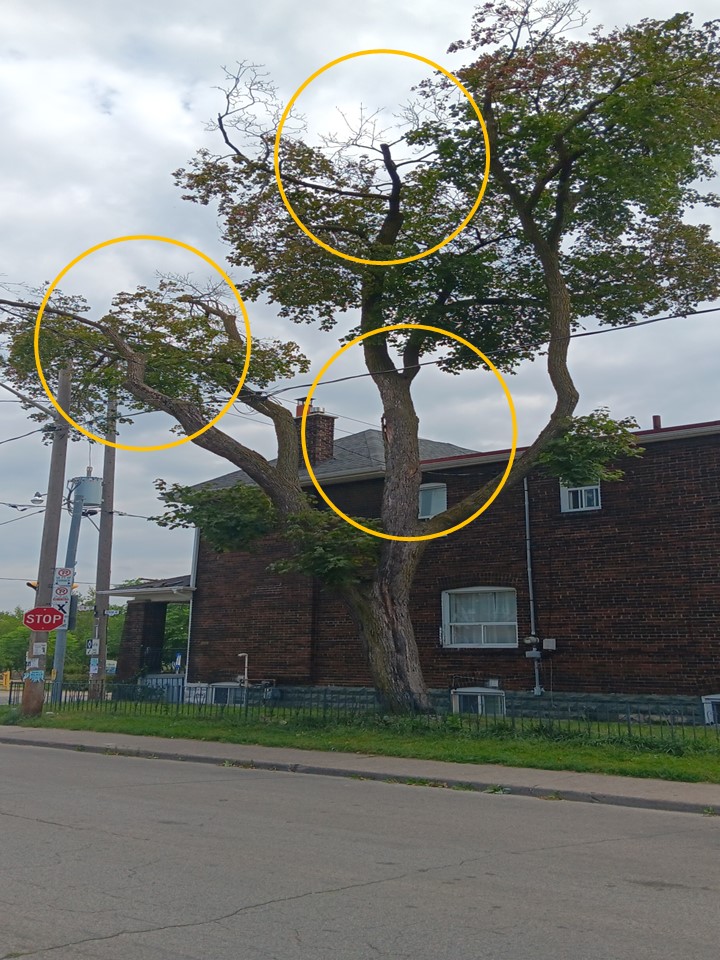This July, LEAF staff checked up on trees that were planted through our Toronto Community Housing Planting and Stewardship Program to monitor their health using the Neighbourwoods Tree Inventory Protocol. Developed by Dr. Andy Kenney and Dr. Danijela Puric-Mladenovic at the University of Toronto Faculty of Forestry, the Neighbourwoods assessment is a standardized data-collection method designed to help citizen scientists conduct an inventory of their urban forest, assess overall health, and strategically plan stewardship interventions.
The great thing about the Neighbourwoods Tree Inventory Protocol is that anyone can assess the trees in their own community. Here are a few key signs that we look out for when checking trees on TCHC properties that you can also keep an eye out for with the trees in your own neighbourhood.
Hard Surfaces
Trees need ample space for their roots to grow. Depending on the species, the roots can grow two to three times as wide as the canopy! Hard surfaces located directly around a tree can impact a tree’s ability to expand its roots. Therefore, it might be harder for a tree to stabilize and get nutrients from the surrounding soil.
You can estimate the approximate percentage of area of hard surface surrounding your tree by looking at the ground directly beneath the dripline of the tree. This includes paved surfaces, interlocking pavers, bricks, or even steppingstones. If your tree is surrounded by a large percentage of hard surface area, it might be struggling to get what it needs.
Reduced Crown
The crown refers to the branches and foliage of a tree. Trees create food for themselves through their leaves, and so removing sections of the crown from the tree may make it harder for the tree to nourish itself. The crown is often reduced by human intervention when branches are removed to reduce a tree’s interactions with power lines, buildings or other human-made structures. Has your tree had branches removed? This might be a cause of stress to your tree.
Defoliation
Defoliation refers to a loss of leaves on a tree’s branches, which could be caused by many stressors such as a lack of water, infestation or disease. Remember how trees convert sunlight into energy through their leaves? If a tree suffers a great amount of leaf loss, especially repeatedly over many years, the tree may eventually die. To tell if your tree suffers from defoliation, look at the branches that reach all the way to the tips of the canopy, rather than on the branches that are close to the trunk. Defoliation on the inner limbs is completely normal. However, if you are seeing a significant lack of leaves on the outermost branches of your tree, it may be stressed.
Two key things to keep in mind about defoliation:
- Some tree species can be naturally sparse, like the honey locust tree (Gleditsia triacanthos). Knowing the typical leaf density of a tree species can be helpful in determining if the tree you are assessing has defoliation.
- At certain times of the year, leaves will not be present on trees. For example, it’s very normal for a tree to be fully defoliated in winter, leaf out late in the spring or be first to drop its leaves in the fall. Knowing how your tree behaves can help eliminate any unnecessary concern.
At the end of the day, show your tree that you care.
LEAF works with TCHC tenants and site staff to establish Tree Care Teams. The teams are made up of tenants who are trained to look for tree stress and actively take care of TCHC trees. You can also do the same for the trees in your yard or community! If you have noticed any of these signs of stress in your tree, make sure to give it the support it needs through consistent watering and seasonal mulch applications. We recommend watering twice a week with six gallons of water (3 full, large watering cans), or fifteen minutes with the hose on a slow trickle. Additionally, mulch can be applied twice a year, ideally in the spring and fall, to support moisture retention and provide extra nutrients. Make sure to apply the mulch in a donut shape rather than a volcano to avoid wood rot!
If you continue to see signs of stress with your tree, you can reach out to a certified arborist through the International Society of Arboriculture.
Bracha is the TCHC Stewardship Assistant at LEAF.
The TCHC Planting and Stewardship Program is implemented by LEAF, TCHC and the City of Toronto. It is funded by the City of Toronto's Urban Forestry Grant and the TD Green Space Grant from TD Bank Group and the Arbor Day Foundation.



